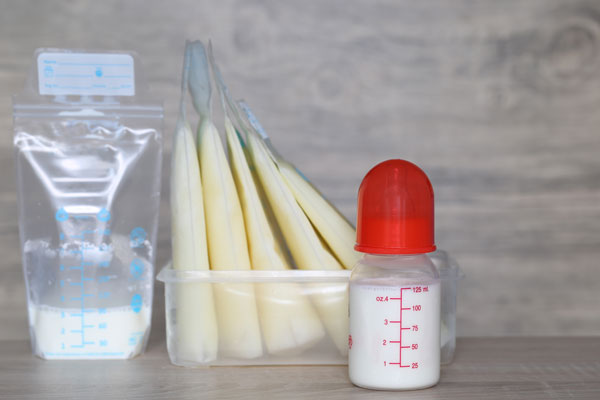Every breastfeeding mother, new or old, have experienced this concern during the breastfeeding journey. Is my breastmilk have enough fat content? And how to make breastmilk fattier? Yes, this is an issue for various mothers, and in this article, I tried to help you.
I have discussed the basic composition of breastmilk and lactation phases to know what nutrients are present in the breastmilk and their quantity. Then I focused on the lipids or fats present in the breastmilk and their importance in a baby’s growth and development. Further, I shared the tips you can use to make your breastmilk fattier and the things you should avoid.

Mother’s milk is the best source of nutrition for babies. Research studies have shown that breastmilk is composed of a variety of macronutrients, micronutrients, and bioactive agents necessary for the baby’s optimal growth and development.
It also develops immunity in the baby to fight against various infections and diseases. Moreover, breastmilk tends to change with the needs of your baby. Below mentioned are the significant nutrients present in human breastmilk.
Composition of breastmilk
Before specifically discussing the fats in breastmilk, let’s talk about the nutrients present in the breastmilk.
Macronutrients in breastmilk
Breastmilk is primarily composed of water, carbohydrates, proteins, and lipids or fats. Each nutrient plays a significant role in the growth and development of the baby.
- Water is the 90% content of breastmilk and is responsible for hydration, maintaining body temperature, protects organs, and in short, maintain life-sustaining bodily functions.
- Carbohydrates are 7% of breastmilk and mainly constitute lactose. It is responsible for the healthy gut bacteria or gut microbiome, thus protecting the baby from gastrointestinal issues.
- Proteins makeup 1% of the breastmilk and help in building, strengthening, and repairing body tissues. It is also needed for the production of enzymes, hormones, and antibodies in the body.
- Lipids are present 2 to 4% in the breastmilk and serve various important functions.
Micronutrients in breastmilk
Human milk has vitamins and minerals necessary for the healthy growth of the baby and is called micronutrients. These made up 0.2% of the breastmilk.
- Vitamins like vitamin D, B6, and folate are necessary for healthy bones, eyes, and skin. They also help in the prevention of malnutrition.
- Minerals including iron, zinc, calcium, sodium, magnesium, chloride, and selenium are necessary for the red blood cells production and promotion of muscle growth and nerve function.
Bioactive components
These are the nutrients and substances unique to the human breastmilk and are not present in formula milk. These are present in traces in the breastmilk and include antibodies, enzymes, and hormones.
- Antibodies are necessary to fight off infections and illnesses. Antibodies in breastmilk help protect against the common cold, ear infection, gastrointestinal issues like nausea, vomiting, diarrhea, and various other infections.
- Hormones are responsible for various bodily functions, including metabolism, growth, fight and flight responses, regulation of automatic body functions, etc.
- Enzymes in the breastmilk perform various roles in the body, among which a lot of functions are still unknown. The various functions include digestion of food and breaking down proteins and fats.
These are the significant nutrient substances present in the breastmilk, and there are various other nutrients, including probiotics and anti-infective factors.
Lactation phases
The breastmilk composition changes during the first two weeks post-partum. Breastmilk goes through three stages during lactation: colostrum, transitional breastmilk, and mature breastmilk.
- Colostrum is the breastmilk present during the first few days after delivery and is rich in antibodies and immunoglobins necessary to boost immunity and fight infections. Colostrum has high levels of proteins and low levels of fats and carbohydrates. It is thick, sticky, and yellowish-orange in color.
- Transition breastmilk contains the properties of colostrum and mature milk and is present for two weeks. It is rich in proteins, carbohydrates, fats, and bioactive nutrients.
- Your breasts produce mature milk once your baby becomes four weeks old. It contains all the necessary nutrients that are vital for the optimal growth and development of your baby.
- Most of the time, mature milk is classified as foremilk and hindmilk; however, mature breastmilk has no types to be very clear. Foremilk and hindmilk are both parts of the breastmilk and contain essential nutrients for your baby’s health.
Lipids in the breastmilk
We have the basic overview of breastmilk and its composition; we can continue with our main topic. Among various nutrients present in the breastmilk, the main focus is on the fats or lipids present in the breastmilk.
Fat is a major component of the breastmilk and comprises 50% of breastmilk’s energy. The fat content in human milk is highly variable. It is different in different women as per ethnicity, the climate of the residence, age, lifestyle, number of pregnancies, current and pre-pregnancy weight, and lifestyle. It also has different concentration and content in a mother at different ages of baby, at a different time of day, and even during a single feed from start to end.
The fat or lipid secretes in the form of small droplets in the milk. The amount of fat in the milk increases with the progression of a feeding session. Thus, the foremilk, secreted at the beginning of the feed, has less lipid and rich lactose. In comparison, the hindmilk that is secreted later in a feed has more fat molecules.
Why hindmilk has more fat content?
Milk is produced in the alveoli, the grape-like structures in the breasts. When the baby sucks the milk, the fat molecules tend to stick to the milk ducts, and the light milk, i.e., the foremilk, flows rapidly. Once the foremilk passed, the fat molecules slowly get unstuck from the walls of the ducts and get to your baby. Thus it makes hindmilk rich in fat.
Various types of lipids in the breastmilk
Multiple kinds of lipids are present in the breastmilk, among which, functions of some are known while others are unknown. The significant lipids present in human milk are mentioned below.
- Triglycerides constitute 98% of fat in breast milk and are the energy reservoirs of the body.
- Cholesterol is vital for brain and neural development. It also regulates the hormones and is responsible for better cardiac health and decreased risk of cholesterol issues in later life.
- Docosahexaenoic Acid (DHA) is important for the central nervous system development and the maturation of vision.
- Arachidonic acid has a significant role in the baby’s growth and development; however, the mechanism’s exact action is still not understood.
- Complex lipids are vital for the healthy brain, stomach, intestines, and skin of the baby.
Importance of fat content in the baby’s development
Lipids and fats are a significant source of energy provided by breastmilk. Following are the functions that are performed by fats.
- Infancy is a period of intensive brain growth that contains high amounts of ARA and DHA. This suggests the importance of lipids and fats in the neurological and cognitive development of the baby.
- Also, fats are engaged in inflammatory and immunological functions. This indicates the significance of fats in the optimal maturation of a baby’s immune system.
- Different fats also involve the absorption of minerals in the bloodstream, intestinal comfort, increases bone density, and decreases the baby’s crying behavior.
How to tell if your breastmilk has enough fat content?
Most of the time, the breastfeeding mothers, especially first-time breastfeeding mothers, heard about fattiness and its importance for the baby’s growth. They usually lookup breastfeeding-related information and got concerned about whether their breastmilk has enough fat content.
If you express or pump your milk and leave it for a few hours, you can see your milk get split. The fat contents are the creamy layer at the top of the milk, while beneath that is what we call skim milk that contains water and lactose.
What is a fat plug?
Some mommies note a thick layer of fat on the bottle when they take out stored breastmilk. It looks like a seal or plug and makes the pouring of milk difficult. This thick layer of fat is also known as a fat plug. Such high fat content is observed in the breastmilk but occasionally and produced by the breast according to your baby’s needs.
Is the fat content in your breastmilk enough for your baby?
But the important thing to keep in mind here is that your breastmilk contains exactly what and how much nutrients your baby needs. It changes according to the weather and health of your baby. So, there is no need to worry unless you are noticing the following signs.
- Your baby is not gaining enough weight or below his weight percentile.
- Your baby’s stool is unusual, or he is not pooping.
- His diaper output is low.
- He is lethargic and is not actively responding as he should.
These are some signs, and there could be millions of reasons for such symptoms. So, if you are noticing such unusual behaviors in your child, consult the pediatrician. If he suggests that the problem is low fat, you can ask all your questions and concerns.
Tips on how to make breastmilk fattier
Can you make your breastmilk fattier? No. But you can use some tips and strategies so that your baby gets all the fat produced by your breasts. Following are few things that can help you in relieving your anxiety.
1.Nurse frequently and on-demand
There is a rule of thumb here. The fuller your breasts are, the lower the fat there will be. This is because full breasts have more lactose or what we called as foremilk. You have heard the example of a faucet here. When you first turn your faucet, the water will take some time to get warm.
However, if you turn it off and then on again after some time, it will still be slightly warm. The same is the case with breastmilk, and in this case, warm water means fatty milk. So nurse frequently and on-demand. There are mothers to try to feed by schedule, but this will impact the milk production and lowers your milk supply.
2.Time of feeding
There are certain times of the day when the fat content in milk is high. Research studies have suggested that fats and lipids in milk tend to be lower at night and early morning. In contrast, the fattiness is higher during the day. This could be because babies feed less frequently and mothers have more foremilk. But again, what you can do is offer your baby breast whenever he needs it or whenever your breasts feel full.
3.Nursing position and latching
Poor latch and feeding position influences the baby’s ability to suck and swallow milk. This can cause weight loss and poor diaper output, making mothers think that the milk is not nutritious enough for the baby. You can observe signs of a poor latch, like clicking sounds during breastfeeding. Or you can consult a lactation expert for guidance.
4.Breast compressions and massage
You can try breast compressions and massage, which can help release the fat molecules stuck to milk ducts and get incorporated into the milk. This will also lose the small lumps you feel in your breasts before feeding.
5.Mother’s diet
Most of the time, breastfeeding mothers are suggested to use fats in their diet to increase breastmilk’s fattiness. While some others advocate that a mother’s diet has no influence on the fats in the breastmilk. The reality is that the fat contents are not increased in the breastmilk because breastmilk contains the fat amount necessary for your baby.
However, the mother’s diet influences the quality of fats present in the milk. If you eat healthy fats, your milk will contain healthy fats. If you consume more saturated fats in your diet, your milk will have more saturated fats without altering your milk’s total quantity of fats.
Consuming healthy fats like nuts, meats, fish without mercury, seeds, eggs, vegetables, and vegetable oil like olive oil helps maintain healthy lipids in breastmilk.
It is not only what you eat during pregnancy or lactation, but your eating habits before pregnancy that influence your breastmilk’s fat content.
The fats in breastmilk are derived from the mother’s diet and the stored fat present in the mother’s body. That’s why breastfeeding leads to weight loss after pregnancy.
So, you don’t need to incorporate excessive fats into your diet. Instead, you need to add balanced and healthy fats to your diet.
6.Duration of lactation
It is also evident from research studies that mothers who are nursing their babies for longer have a greater amount of fat in their breast milk than those who are nursing for a short period of time.
Suppose your baby is of 6 months; thus, you are nursing him for 6 months. And there is a mother with a one-year-old, and she is nursing for a year. Automatically she has more fats in her breastmilk as compared to yours. It is because her baby has greater nutritional needs as compared to yours because of his age.
7.Sunflower lecithin
Sunflower lecithin is a natural emulsifier used by breastfeeding mothers to increase milk flow and fat content in the breastmilk. It keeps the fat droplets in your milk suspended rather than getting stick to the walls of ducts.
Various mothers and also doctors recommend lecithin for plugged or blocked ducts. You can use this with the recommendation of your doctor.
8.Other galactagogues
There are various galactagogues suggested by elderly and fellow mothers, and some swear by these supplements, herbs, teas, cookies, energy bars, and foods. However, there is no scientific basis for the use of these galactagogues. You can use these if you want, but there are always some risks associated with using such methods.
What should you not do to increase fat content in your milk?
These are somethings that you can try to ensure that your baby receives all the fats and lipids produced by your breasts. However, certain things are frequently recommended but should be avoided.
1.Pumping and discarding foremilk
The most common tip you can find on the internet when you search for ways to make breastmilk fattier is to pump and discard foremilk. It is suggested that you should first pump your milk when it’s time to feed the baby. This way, you will already take out the foremilk, and the baby will get the fatty milk of hindmilk.
As I mentioned earlier, foremilk is as important for a baby’s growth as hindmilk. Foremilk contains carbohydrates in the form of lactose, responsible for 40% of the energy content in breastmilk.
If you only give your baby a hindmilk, it will create a foremilk/hindmilk imbalance and make your baby sick. Also, pumping before nursing will make breastfeeding stressful for you and make your baby very hungry and angry.
2.Offering one breast per feed
Some mothers also get the advice to limit a feed to one breast so that the baby emptied the breast. But this tip is not helpful because this can compromise your breast supply. When you don’t feed your baby from both sides, your breasts get the message to make less milk—thus reducing your milk supply in the long run.
Moreover, if you offer one breast, your baby may leave unsatiated. So you should always offer a second breast when your baby stops feeding on one side. This will ensure that your baby is fully fed and is not hungry anymore.
3.Consuming herbs and supplements without consulting a doctor
If you never used or consumed the herbs or recommended or recommended foods, it is always safer to consult your doctor. It is because these can cause allergies and other symptoms in you and your baby.
Fat is important for your baby’s development, but always remember that your body produces the exact combination of nutrients in your breastmilk necessary for your baby. Whether it is foremilk or hindmilk, every drop of breastmilk is healthy and essential for your baby’s optimal sustenance. There is no need to worry unless you see clear signs.
If you observe any unusual symptoms, seek professional help as soon as possible. In the end, you are the best judge of your baby’s behavior but don’t follow any advice blindly and always do your research.




